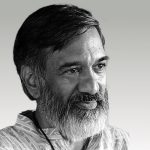Home › Nugget

10 - Doing versus Being - Raghu Ananthanarayanan on Leadership lessons from The Mahabharata
Raghu speaks about the distinction between DOING and BEING. He speaks about BEING as a regenerative process, something that heals and nurtures. He also speaks about the need for coherence between what we are doing and who we are being at various points in time and not resolving this is often at the root of what people often describe as a mid-life crisis.
More from same Guest
Raghu reflects on his childhood and how his grandfather would read the Mahabharata or the Ramayana and also use those stories as an opportunity to share a self-reflective story about their life. He speaks about how this approach might have influenced his style of interacting with people and his teaching approach.
Raghu speaks about some of his choices post his undergraduate degree from IIT Madras. He speaks about how he was influenced by the times he was in and the people he came in touch with (Student Revolutions around the world, Meeting Dharampal etc). He goes on to talk about how Dharampal urged him and some of his friends to spend a decade going deep in a subject before moving on to make a difference.
Raghu speaks about the notion of being Dharmic and how it can be simply defined using three filters – 1) How is it enlivening you? 2) How is it enlivening the person you are interacting with? 3) How is it enlivening the wider context you are in? He goes on to speak about how he has discovered his Dharma in his journey.
Raghu speaks about the distinction between Archetypes and Stereotypes when it comes to relating to some of the historical characters like the Pandavas. He goes on to talk about the defining characteristics of each of the Pandavas and how each one of us might end up having some elements of each of these in us.
Stereotypes when it comes to relating to some of the historical characters like the Pandavas. He goes on to talk about the defining characteristics of each of the Pandavas and how each one of us might end up having some elements of each of these in us.
Raghu speaks about the notion of resolving Dharmasankatas – the double bind situations where there are no easy answers. He speaks about how Indian leadership (going back to King Vikramaditya) has had an emphasis of resolving Dharmasankatas. He goes on to speak about the Leadership traits that help in resolving these tricky situations.
Raghu makes an interesting observation. He says that while Bhagwad Gita was a discussion between Krishna and Arjuna on the various dilemmas the latter was facing, it could have well been a conversation between Krishna and Karna. He says that Karna was so consumed by his hurt that he never even saw the dilemma and that was a missed opportunity. He connects this to several people and communities that might be going through a similar phenomenon.
Raghu expands on the notion of Shantham and calls it the state of quiet high potential but something that’s completely silent. He likens it to someone like a Roger Federer who is in “flow”. He calls it the state where one is fully alert and fully alive and open to all possibilities. He also speaks about how busy leaders can try and access that space of Shantham.
Raghu speaks about the evolving paradigm of leadership and how that’s likely to look like a combination of Arjuna, Nakula and Sahadeva. Yudhishthira and Bheema might possibly be not as relevant as they were in a more predictable past.
Raghu speaks about the distinction between DOING and BEING. He speaks about BEING as a regenerative process, something that heals and nurtures. He also speaks about the need for coherence between what we are doing and who we are being at various points in time and not resolving this is often at the root of what people often describe as a mid-life crisis.
Raghu speaks about the Nakula archetype that often creates the emotional infrastructure in an organization. He speaks about how such leaders might have to flex and demonstrate some of their other elements to build trust when they move to a new context. He also speaks about the link between having this emotional infrastructure and agility that a company might need to respond to sharp changes in the reality of the world.
Raghu spells out the distinction between Shakti (internal forces) and Balam (external forces). He expands on each and discusses them. He speaks about three types of Balam – Asana Balam (Position, Status, Resources), Yoga Balam (Political capability, Friends, Enemies), Kala Balam (Timing, Market readiness). He expands on the three types of Shakti – Icha shakti (conviction, intent), Gnana shakti (intelligence, competencies), Kriya shakti (taking action). He speaks about the criticality of aligning Shakti and Balam as we go through life.
Raghu speaks about his journey on three fronts as an action researcher – Understanding how Systems work, Study of Yoga in depth with Krishnamachari, Process work with Prof Pulin Garg. He also speaks about how he has experimented and engaged with institutions like the Murugappa Group, TCS and Core Healthcare. He speaks about how he has used some of these organizations as a laboratory to try and develop some leadership development and culture building approaches that have been tried and tested.